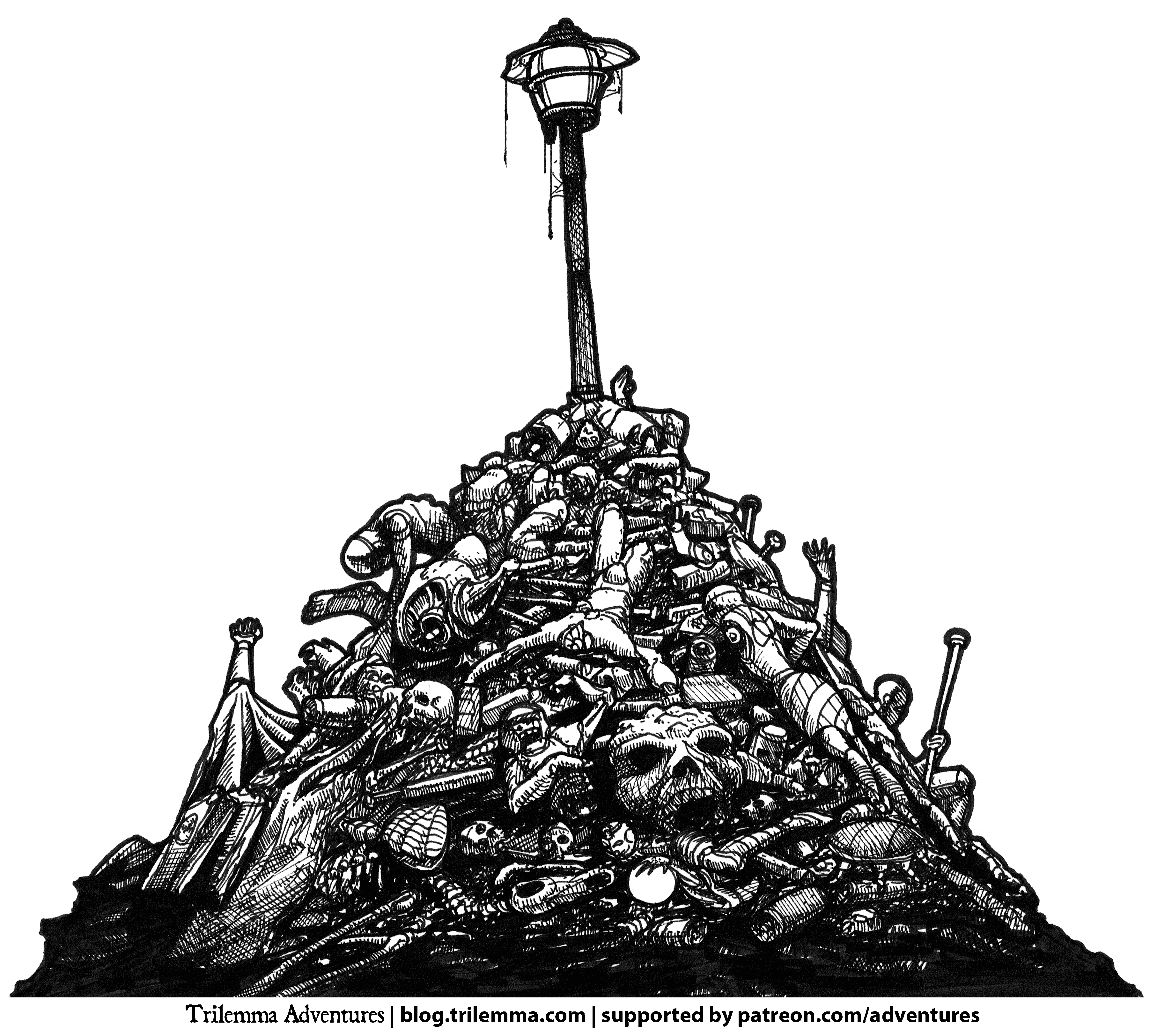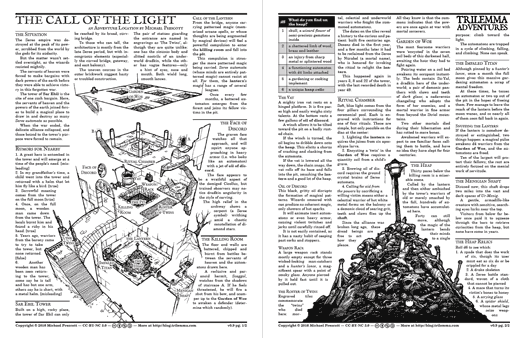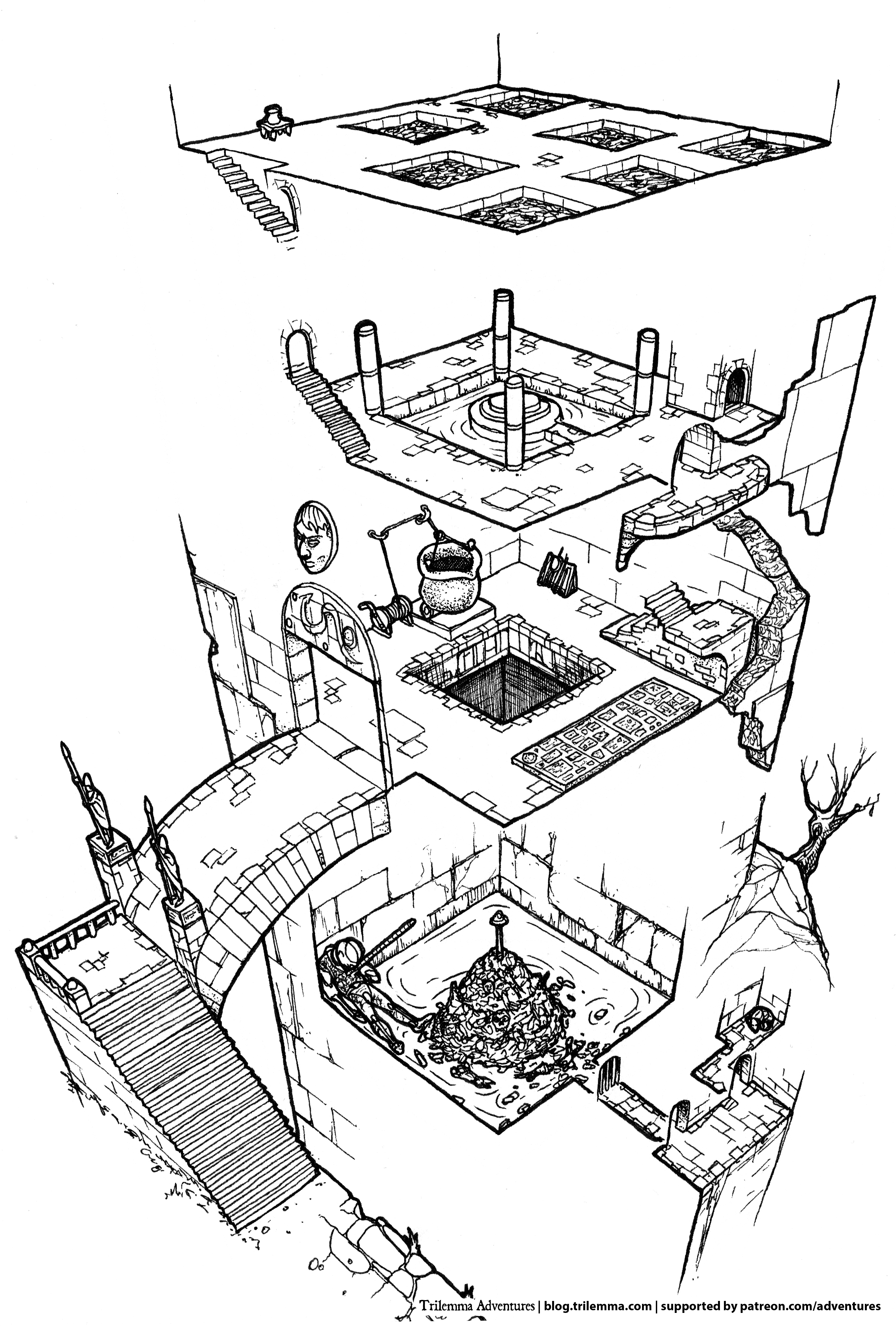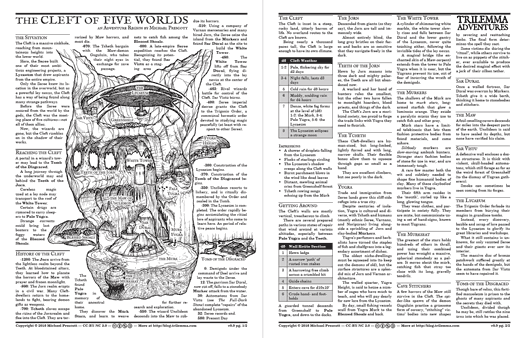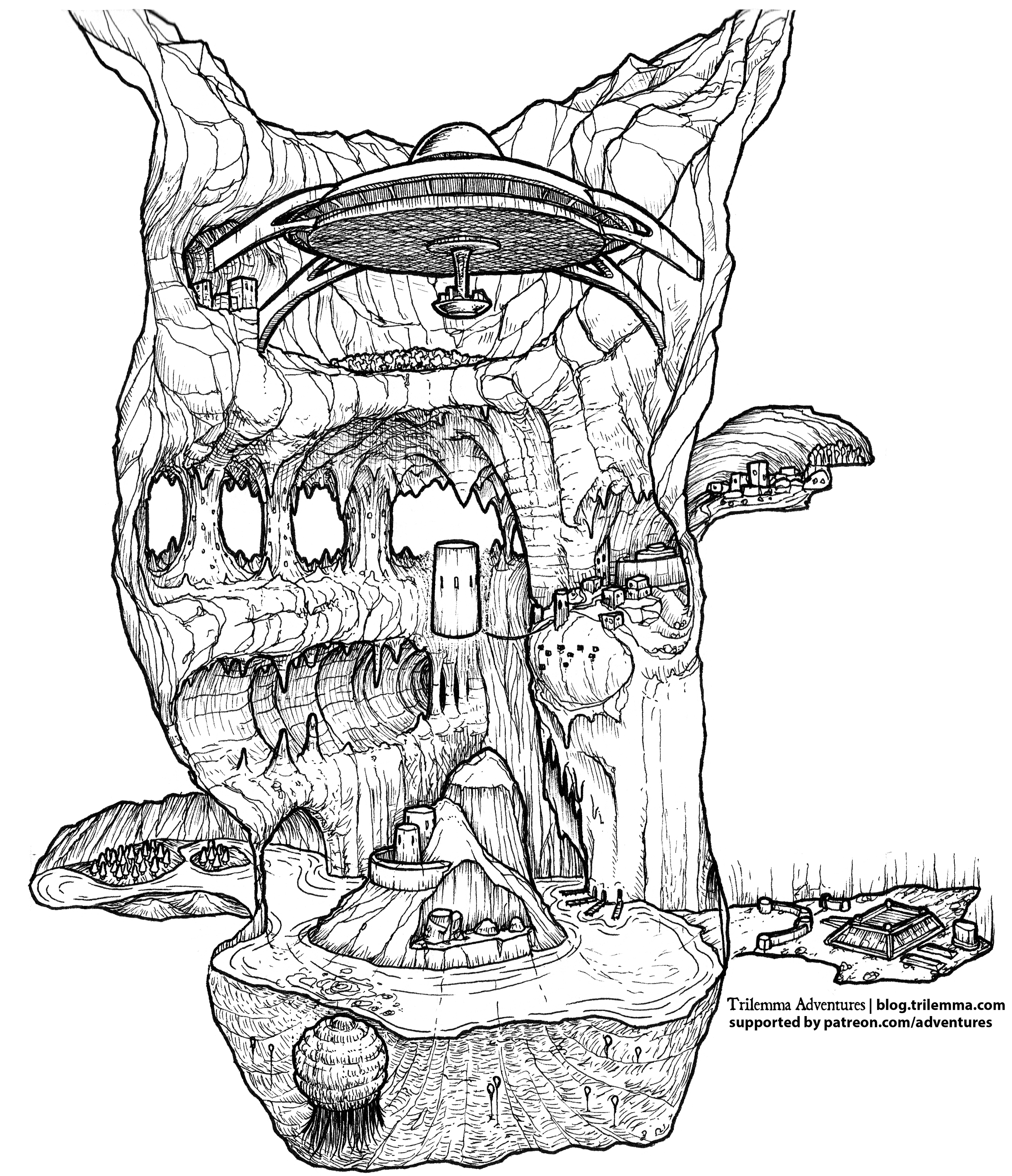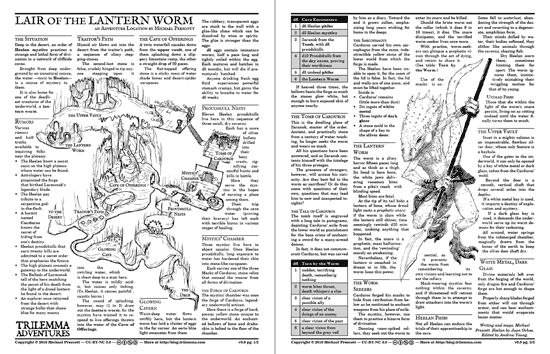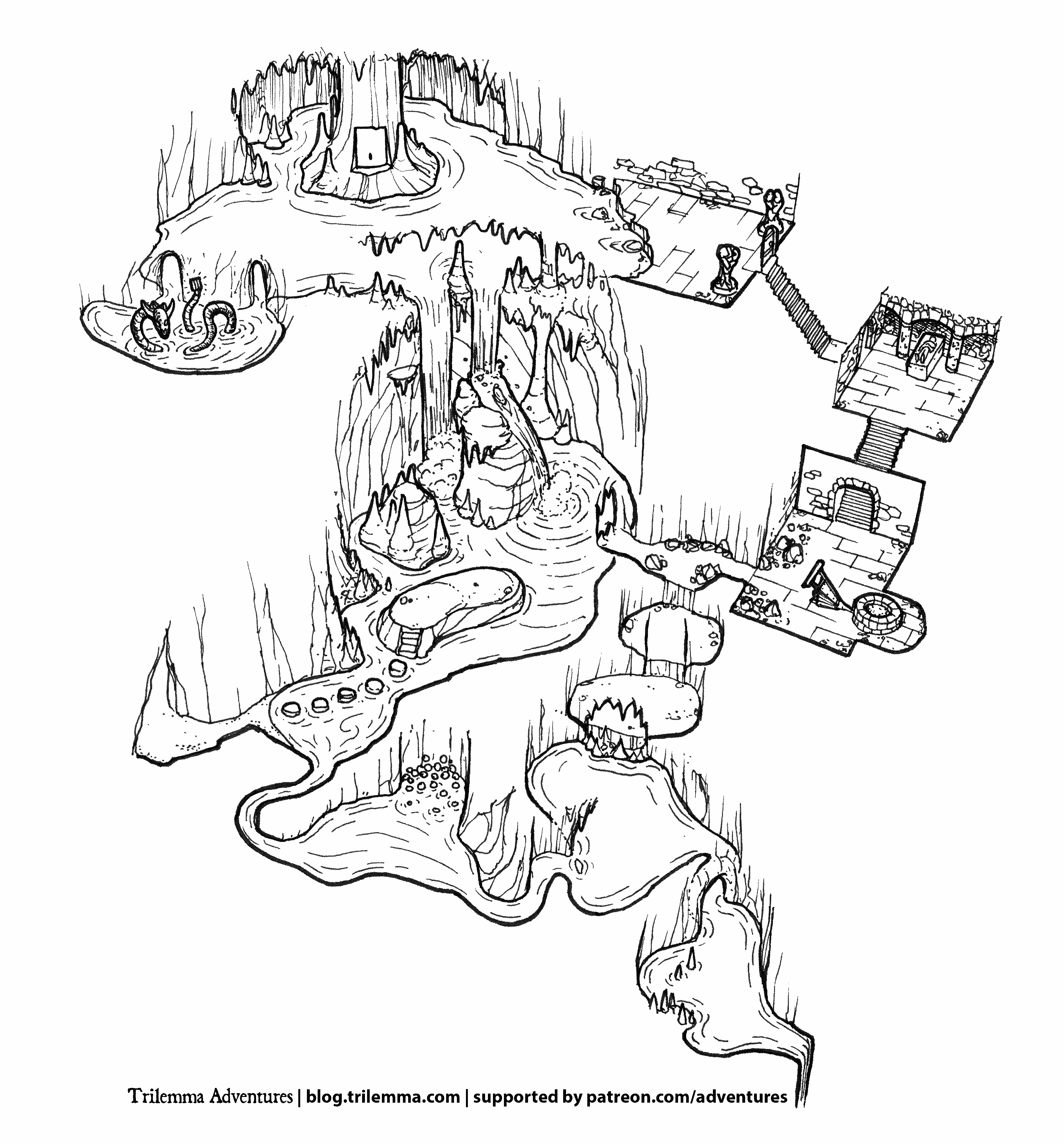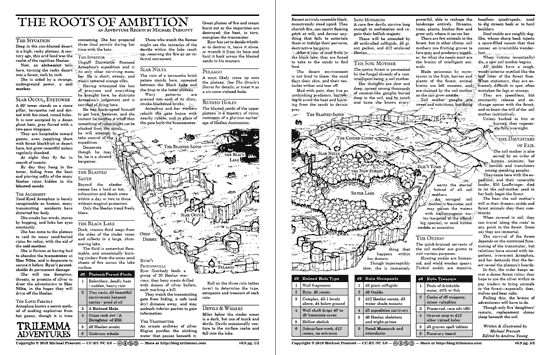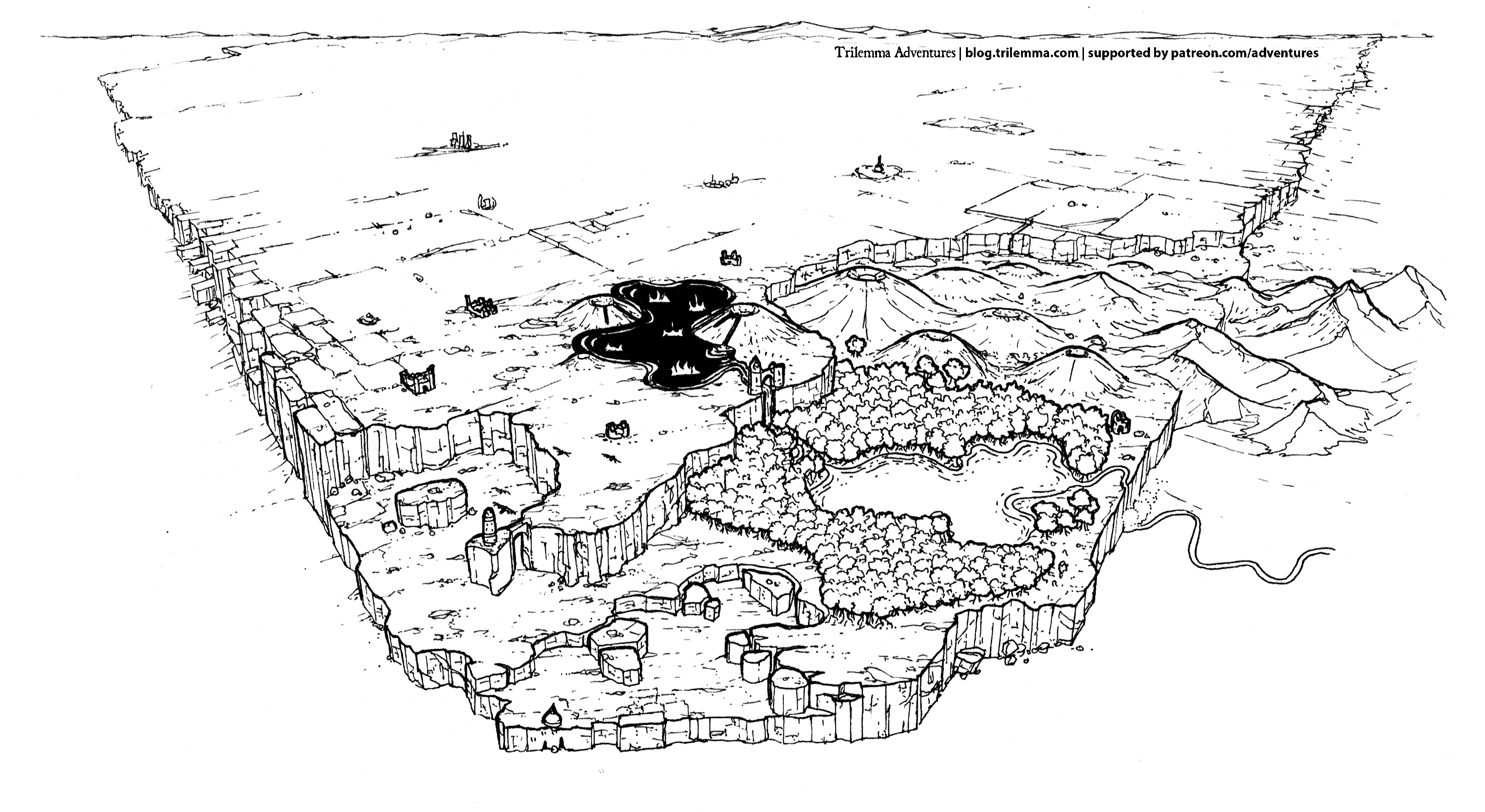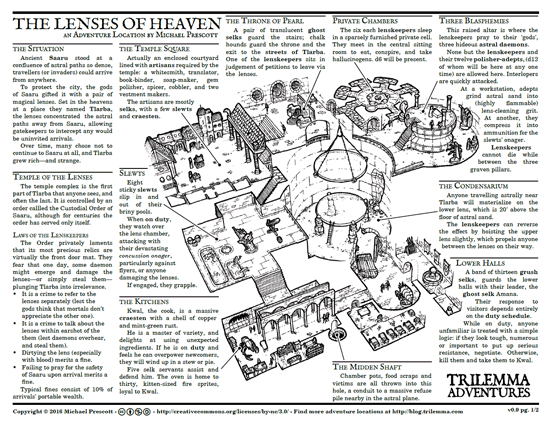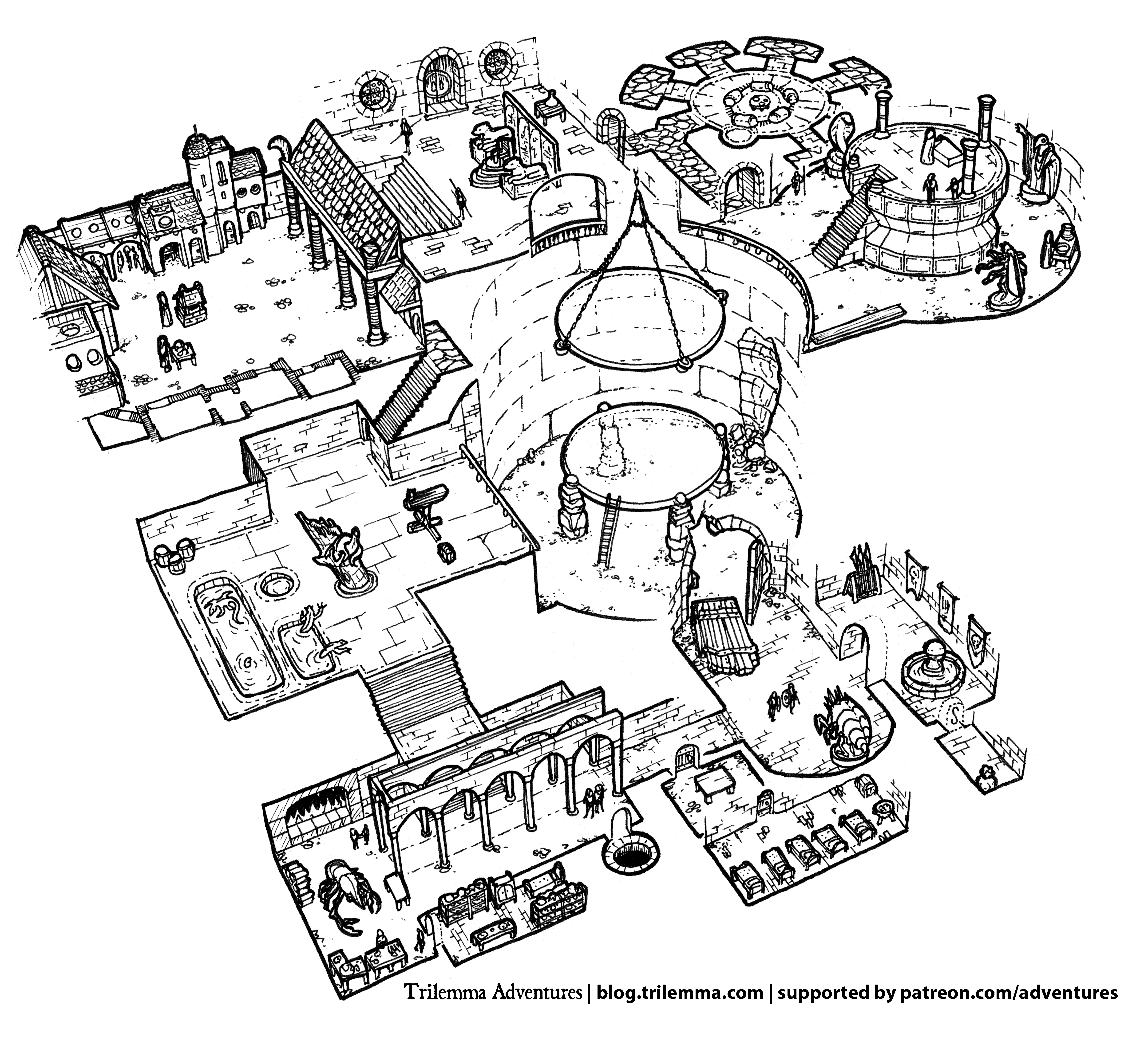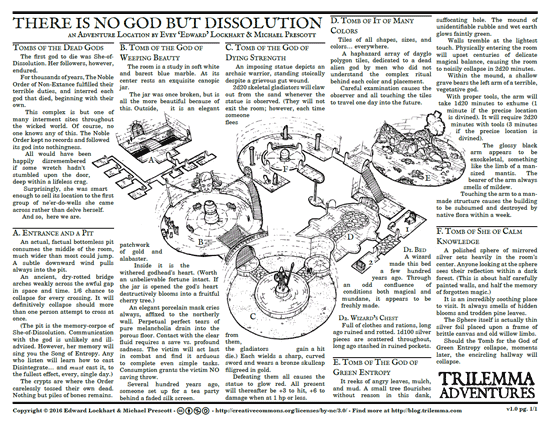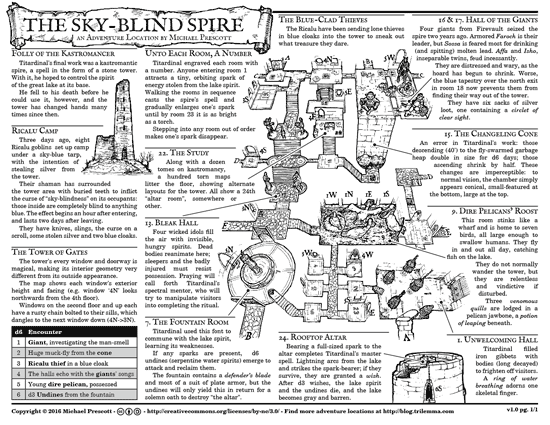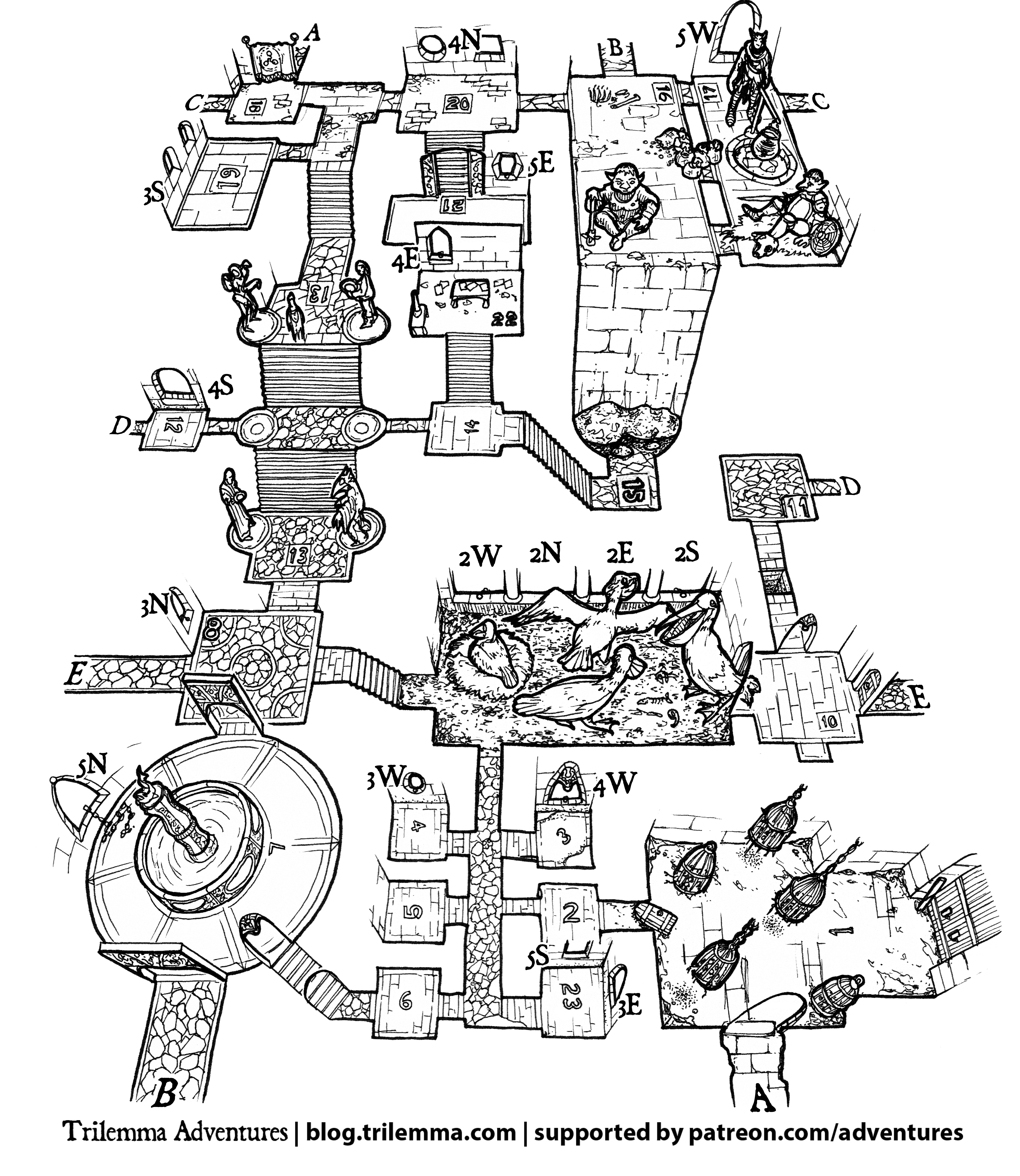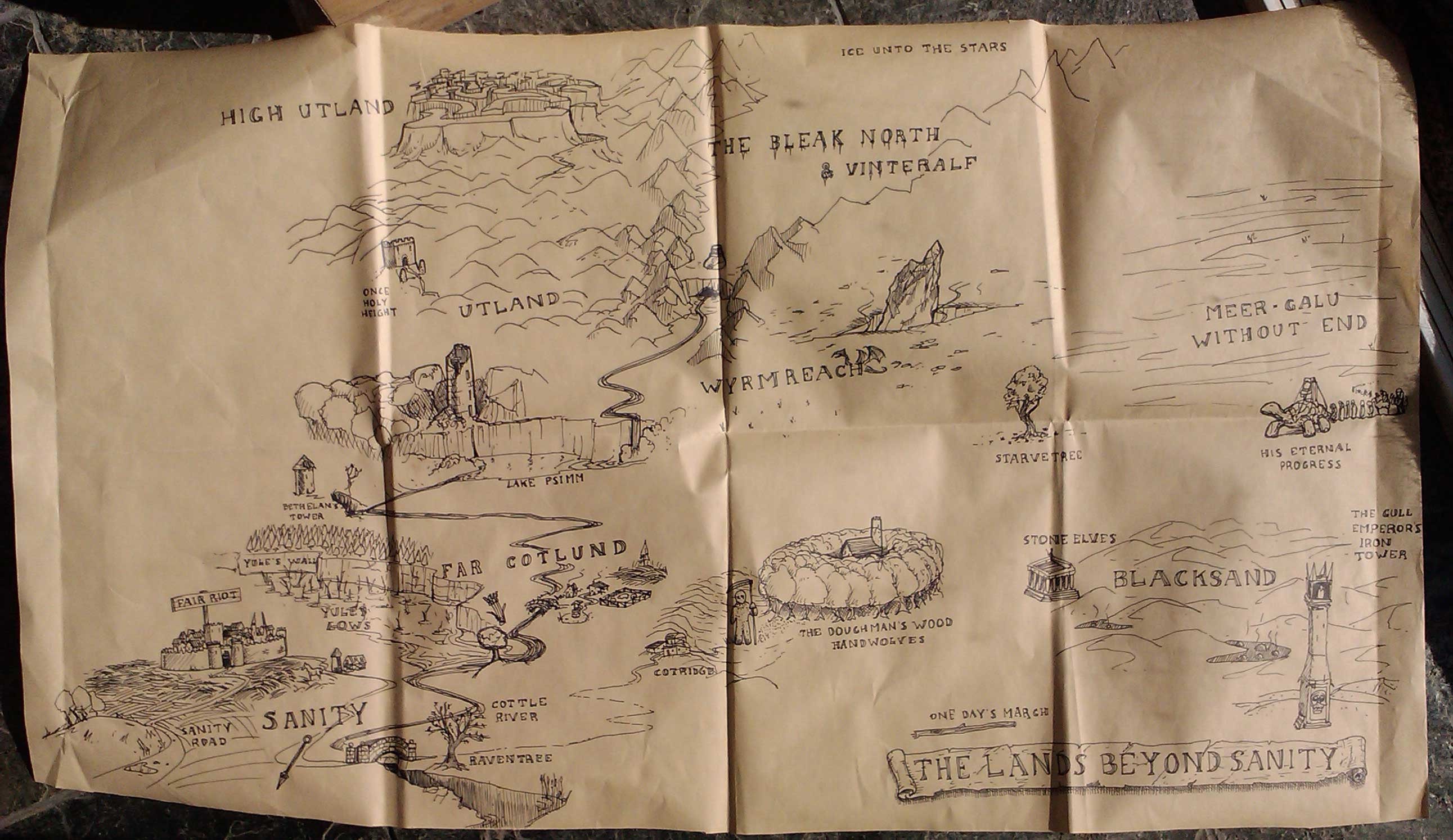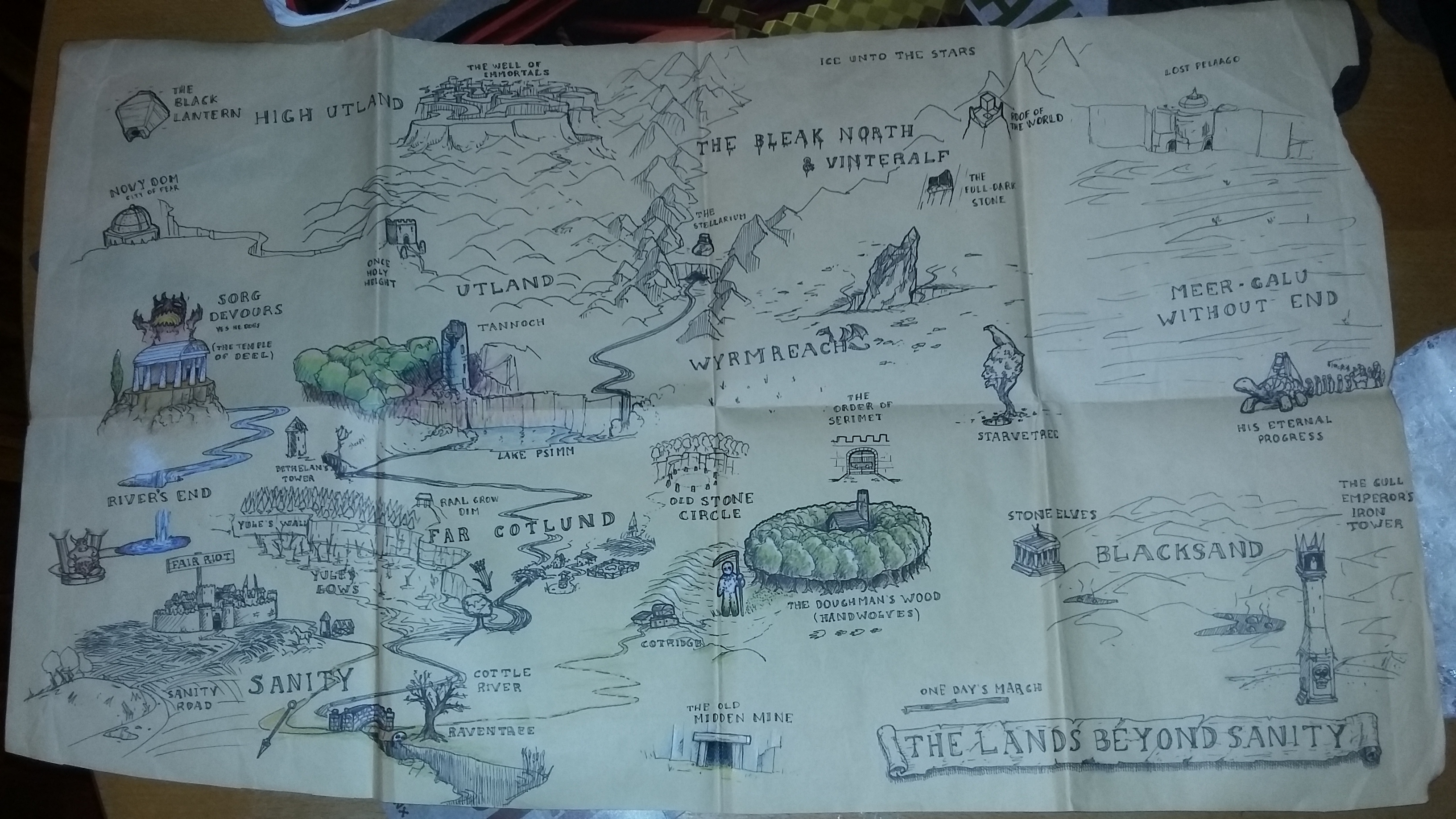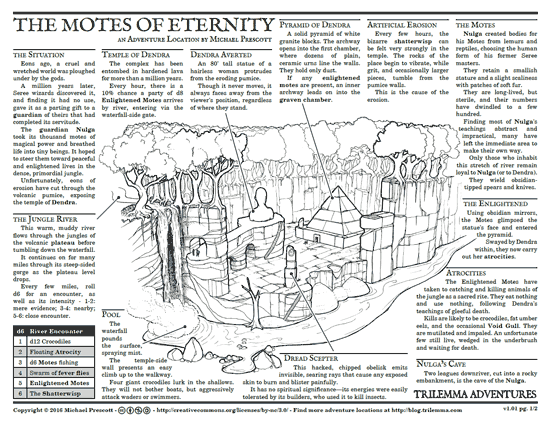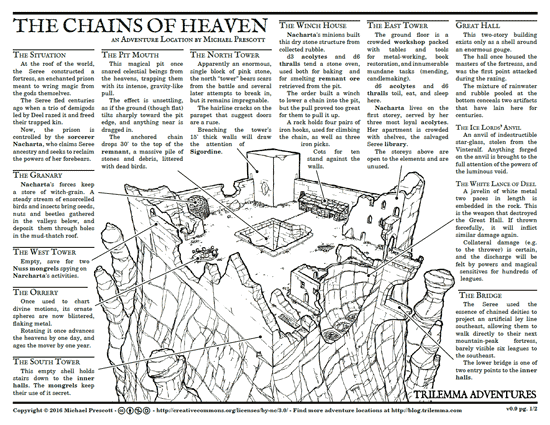Tuesday, 27 December 2016
Project Coma
For something completely out of the blue, here are the player-side documents for v0.1 of 'Project Coma', a scribble of an RPG.
It's heavily inspired by Lacuna Part 1 by Jared Sorensen, but with an Apocalyse World-style rule set and playbooks, with a sprinkling of Amber, Night's Black Agents. Or, to put it another way, imagine if John le Carre and Kafka teamed up to rewrite Inception.
Having said all that, this document is super thin, as much an invitation for a playstorming session as anything.
Project Coma v0.1 PDF
Saturday, 10 December 2016
Which Way to the Sun?
File this under "perspective is weird". Last summer on a camping trip, we were stargazing just after sunset. I remarked how—bizarrely—the lit region of the moon appeared to point above the horizon, despite the fact the sun was below the horizon.
What the heck is happening?
A recent blog post by Randall Munroe (which I can't find right now) asserted this was impossible, which made me question my memory. I have, however, just seen precisely the same phenomenon tonight, which makes me confident it's a real thing and perspective is just plain weird.
Here's a couple of stills out of a video I shot to prove it. Some things to notice:
1. The moon is way higher in the sky than the sun is. (The moon is perhaps 30 degrees above the horizon, the sun is setting.)
2. Nevertheless, the lit portion of the moon is the upper right quadrant.
3. Without any other markers to suggest what's going on, this is pretty weird.
Fortunately, there are some other markers I didn't realize until I was annotating the photographs: the horizontal lines on the long hardware store that appears in both images.
In the first picture, the roof lines appear to go "up" to the west, in the direction of the sun, but in the second picture, they go back down again. In fact, the horizontal roof line in the first image makes it clear that it's not really the "upper" portion of the moon that's lit at all: the line to the sun is straight south, following the roof line. It's just that in that linear perspective, horizontal lines which are above you appear to go "up" as you get to the edge of your field of view.
Since we're "below" the moon (at least from my Earthen reference point) we can see the partially unlit 'bottom' of the moon and none of its partially unlit "top".
The root error in thinking this scenario is possible is assuming that these lines are straight. You'd actually need a fish-eye lens to see both at the same time, which would force "straight" lines to be curved:
What the heck is happening?
A recent blog post by Randall Munroe (which I can't find right now) asserted this was impossible, which made me question my memory. I have, however, just seen precisely the same phenomenon tonight, which makes me confident it's a real thing and perspective is just plain weird.
Here's a couple of stills out of a video I shot to prove it. Some things to notice:
1. The moon is way higher in the sky than the sun is. (The moon is perhaps 30 degrees above the horizon, the sun is setting.)
2. Nevertheless, the lit portion of the moon is the upper right quadrant.
3. Without any other markers to suggest what's going on, this is pretty weird.
Fortunately, there are some other markers I didn't realize until I was annotating the photographs: the horizontal lines on the long hardware store that appears in both images.
In the first picture, the roof lines appear to go "up" to the west, in the direction of the sun, but in the second picture, they go back down again. In fact, the horizontal roof line in the first image makes it clear that it's not really the "upper" portion of the moon that's lit at all: the line to the sun is straight south, following the roof line. It's just that in that linear perspective, horizontal lines which are above you appear to go "up" as you get to the edge of your field of view.
Since we're "below" the moon (at least from my Earthen reference point) we can see the partially unlit 'bottom' of the moon and none of its partially unlit "top".
The root error in thinking this scenario is possible is assuming that these lines are straight. You'd actually need a fish-eye lens to see both at the same time, which would force "straight" lines to be curved:
Thursday, 1 December 2016
The Call of the Light
As some of the others have done, this adventure started out as a stubborn visual I couldn't get out of my mind: a massive heap of automaton parts under the baleful light of a lamppost.
What brought them there? Why, the call of the light.
As always, thanks to my generous patrons, the art and text for this month's adventures are free for non-commercial use under the CC-BY-NC creative commons license. Enjoy!
What brought them there? Why, the call of the light.
As always, thanks to my generous patrons, the art and text for this month's adventures are free for non-commercial use under the CC-BY-NC creative commons license. Enjoy!
Thursday, 24 November 2016
Isometric Dungeon Tutorial #3 - Village Well
Short little post today to point people to a third isometric drawing tutorial, this time a village well.
After a long dry spell of suffering with OS-basis video editing, I'm back to using a real editor, so I can make the whole thing go by much faster, while still stopping to call out a few things I've breezed by in the past, notably freehand circles.
Tuesday, 1 November 2016
The Cleft of Five Worlds
For better or for worse, the visual that inspired this image has been in my head for more than a decade: a huge, vertically stacked dungeon region, dominated by the massive circular structure created by a cabal of aloof wizards.
Now I finally know what's there!
The Cleft of Five Worlds is an adventure region. Rather than a specific, detailed adventure, it describes a bunch of adventure sites and settlements in relation to one another.
I will revisit it to flesh out its parts in later months, but the enterprising among you will have no trouble stocking it or ripping out bits you want to use elsewhere in the meantime!
Now I finally know what's there!
The Cleft of Five Worlds is an adventure region. Rather than a specific, detailed adventure, it describes a bunch of adventure sites and settlements in relation to one another.
I will revisit it to flesh out its parts in later months, but the enterprising among you will have no trouble stocking it or ripping out bits you want to use elsewhere in the meantime!
Saturday, 1 October 2016
Lair of the Lantern Worm
Deep in the desert, a Heelan death cult flirts with a horror of the underworld to snatch secrets from beyond the gray veil. Click on the thumbnail to download the free PDF:
Although I expect most people will use it standalone, this adventure caps off something of a Heelan trilogy which started way back with The Oracle's Decree, and was expanded on in last month's The Roots of Ambition.
This adventure is also slightly unusual in that it features art by Juan Ochoa, who did an amazing job on a Heelan proudskull.
Although I expect most people will use it standalone, this adventure caps off something of a Heelan trilogy which started way back with The Oracle's Decree, and was expanded on in last month's The Roots of Ambition.
This adventure is also slightly unusual in that it features art by Juan Ochoa, who did an amazing job on a Heelan proudskull.
As you all probably know by now, this goodness (or badness?) is supported by a bunch of generous folks who back my Patreon campaign. If you find this content useful or inspiring, consider tossing a buck in the jar!
Saturday, 10 September 2016
Isometric Tutorial Videos
I've started a series of isometric tutorial videos, showing how I draw various pieces of dungeon architecture. So far I've done some stairs and a set of arched double doors.
I'm using graph paper from Incompetech, specifically the "isodots", with the dots set to light blue. Using cyan dots lets me pull them out easily with Photoshop (using a black and white adjustment layer with the cyan slider set all the way to white).
The basic points I cover are:
- block out the 3D space the object is going to occupy
- ensure you're rigorously following the isometric lines - all drawings are flat, so this is important to reinforce the impression of three-dimensionality
- finding points in 3D space often happens by finding the intersection between a vertical and a horizontal line (as with the stair creases)
- texture adds character, but must also follow the isometric axes or you'll quickly spoil the 3D impression
- circles are tricky - as with other shapes, first draw the square tht the square that the circle occupies, then draw it as four separate arcs
- draw your objects from the front of your dungeon to the back so you don't accidentally
- draw in pencil first (ideally blue, so you can use the same PS trick to remove it without having to erase)
- use a waterproof pen, so you don't smudge your ink
- use thicker lines to indicate depth changes between objects
Hope it's useful!
Thursday, 1 September 2016
The Roots of Ambition
A money-mad alchemist wages ecological war on a desert plateau. An order of animists, a long way from home, tends to their nascent god.
On the Big Map, the plateau is located in the dry north, on the border between the Far Blightlands and Firevault, but you can place it in any arid spot in your campaign world. It runs standalone, or as a possible follow-up adventure to The Oracle's Decree.
A force in this adventure is a soil mother, one of my favorite monsters, first concocted for my "Burning Grunweld" campaign some years ago.
One of the inherent difficulties in sketching out a whole region and its factions in just two pages is that, because of the huge amount of terrain involved, it's not stocked at hex-crawl densities, and is probably best run more like a point crawl with Lord of the Rings-style encounter densities. This is particularly true if you're running it in a confined time slot like a con.
Speaking of two pages, you'll notice this is the first of my adventures where I'm trying a new layout, deliberately built as a two-page spread. I've chosen to have the map span the gutter, which is a bit of an experiment.
I couldn't resist the wide sweeping effect, but cutting the map in half is a definite trade-off. If you want the map in its unblemished whole, download the image, below.
Once again, many thanks to the patrons that throw money at me when I make these. Because of their generosity, all of the text and imagery in this month's adventure is free for use non-commercially under CC-BY-NC.
On the Big Map, the plateau is located in the dry north, on the border between the Far Blightlands and Firevault, but you can place it in any arid spot in your campaign world. It runs standalone, or as a possible follow-up adventure to The Oracle's Decree.
A force in this adventure is a soil mother, one of my favorite monsters, first concocted for my "Burning Grunweld" campaign some years ago.
One of the inherent difficulties in sketching out a whole region and its factions in just two pages is that, because of the huge amount of terrain involved, it's not stocked at hex-crawl densities, and is probably best run more like a point crawl with Lord of the Rings-style encounter densities. This is particularly true if you're running it in a confined time slot like a con.
Speaking of two pages, you'll notice this is the first of my adventures where I'm trying a new layout, deliberately built as a two-page spread. I've chosen to have the map span the gutter, which is a bit of an experiment.
I couldn't resist the wide sweeping effect, but cutting the map in half is a definite trade-off. If you want the map in its unblemished whole, download the image, below.
Once again, many thanks to the patrons that throw money at me when I make these. Because of their generosity, all of the text and imagery in this month's adventure is free for use non-commercially under CC-BY-NC.
Thursday, 30 June 2016
The Lenses of Heaven
This adventure started out with a weirder-than-usual kernel - immigration control in space.
The legendary astral city of Saaru has long been sought after by sages, adventurers.. and invaders. Once far too easy to reach, Saaru's gods sealed it off behind a hidden choke point, Tlarba.
But over the long centuries, the order that swore to protect Saaru from daemons has itself become corrupt, and what at first looks like a bureaucratic delay will soon become a nightmare for any who pass through the lenses.
The legendary astral city of Saaru has long been sought after by sages, adventurers.. and invaders. Once far too easy to reach, Saaru's gods sealed it off behind a hidden choke point, Tlarba.
But over the long centuries, the order that swore to protect Saaru from daemons has itself become corrupt, and what at first looks like a bureaucratic delay will soon become a nightmare for any who pass through the lenses.
Inserting Tlarba into your campaign world is easy enough - place it in front any otherworldy, interesting destination, or use it to intercept adventurers teleporting or using magical portals of whatever sort.
Thanks again to my many patrons, who along with a bunch of folks on G+ voted for this adventure to be next!
Tuesday, 31 May 2016
There Is No God But Dissolution
As her first and final act, the God of Dissolution evaporated into nothingness. This act of divine self-abnegation echoed through the cosmos, an undeniable proof of what had been thought impossible: even the gods can die.
And die they did, in untold numbers--some torn from reality by their kin, some eroded by dalliances with caustic energies. Some merely lost in the trackless expanse of night.
But even in their passing from the world, mortals came forth to worship and cherish them. A brave and mad few dared collect their broken bodies and bury them, or so the legends say.
A tomb of dead gods would be a dangerous place indeed. Fortunately, no such place exists.
Just kidding, of course it exists.
This month's adventure is a collaboration with the inestimable +Evey 'Edward' Lockhart, who knows her way around a one-page dungeon as well as anyone. I provided the map, and she stocked it wickedly.
As always, many thanks to my Patrons for their support. There's been a mad rush of you arriving from Geek & Sundry in the last few days, welcome!
Because of your support, all of the text and imagery in these adventures is released under CC-BY-NC 3.0. If those terms work for you, feel free to reuse any of this adventure in your own non-commercial publications.
And die they did, in untold numbers--some torn from reality by their kin, some eroded by dalliances with caustic energies. Some merely lost in the trackless expanse of night.
But even in their passing from the world, mortals came forth to worship and cherish them. A brave and mad few dared collect their broken bodies and bury them, or so the legends say.
A tomb of dead gods would be a dangerous place indeed. Fortunately, no such place exists.
Just kidding, of course it exists.
This month's adventure is a collaboration with the inestimable +Evey 'Edward' Lockhart, who knows her way around a one-page dungeon as well as anyone. I provided the map, and she stocked it wickedly.
As always, many thanks to my Patrons for their support. There's been a mad rush of you arriving from Geek & Sundry in the last few days, welcome!
Because of your support, all of the text and imagery in these adventures is released under CC-BY-NC 3.0. If those terms work for you, feel free to reuse any of this adventure in your own non-commercial publications.
Tuesday, 17 May 2016
The Clay That Woke
I'm currently reading through The Clay That Woke, a game by +Paul Czege, and I feel the need to write about it. This isn't a review, since I haven't played, but these are my thoughts so far.
'Clay' is a newer RPG, funded through Kickstarted in early 2014, and delivered without drama later that same year. I was aware of the game back then - Paul's marketing tickled me, as from what I can tell it consisted entirely of him posting minotaur art and asking, "Shouldn't you be thinking about minotaurs?"
A game entirely about minotaurs didn't really grab me, but a few months ago I caught a podcast interview with Paul Czege that did get me thinking about minotaurs.. or at least about Paul Czege. But more on that later.
The reason for all this minotaur art is that—like many indie games—Clay is extremely focused: all of the PCs play minotaurs. Also, they're all male.
Clay is set in and around the "Dégringolade," the sprawling remnant of a jungle metropolis. A couple of generations ago somebody found a quartet of baby minotaurs, unique in the world, sitting on the muddy banks of a river and took them home.
Turns out they're genetically compatible with humans, and as a result of a few unorthodox and sometimes self-destructive couplings, many years later the Dégringolade is thick with an underclass of minotaur slave labor.
I'm going to stop talking about the game for a minute and talk about the book: it's a slim, softcover tome, with delicate newsprint pages but a delightfully sturdy cover. It's only 128 pages, and a large portion of it is fiction.
This is the first of a few unorthodox choices Paul has made in the construction of this game. Rather than bust out a couple of pages of What Is A Roleplaying Game and rolling straight into How To Resolve Conflict, Paul starts off with a narrative about a minotaur.
There's crumbling ruins, cruel slave masters, an endless jungle filled with deadly monsters, but while other games with this setup would quickly get around to just how much ass you can kick as a minotaur, Clay returns to narrative, over and over again, gradually building up a tone painting about the inner lives of minotaurs—their lives, what they care about, their longing and their losses.
The endless jungle around the city is filled with strange creatures, remnants of lost civilizations, even Jorune-esque magic/advanced technology, but exploration, treasure, and understanding the past all seem beside the point. The jungle is chiefly a window into the soul - a carnivorous holodeck, a dream-like realm where casual violence and everpresent mortal danger reveal what the minotaurs are made of.
The minotaurs are helplessly drawn back to the jungle, over and over again to recharge their essence and learn whatever terrible or beautiful lessons it has for them.
Terrence Malick comes to mind a lot as I read, Rudyard Kipling, too. Even a little Robert Bly.
What also strikes me, as it did when I first heard the aforementioned podcast interview, is Paul's sensitivity, his openness to getting inspiration from his personal emotional roots. Grist from his childhood, percolated through whatever dark, psychic soil role-playing games sprout from.
The narrative is there because it's necessary - it takes that long to really feel what Paul's on about. The whole book is like a plea to listen just a while longer, because when you get it, it's going to leave a mark.
The art by +Nate Marcel is gorgeous - it's not showy, but it's spot on, and provides a lot of the visual imagery that tells you what sort of place the city is. Everyone's naked, for one thing, which reinforces the sort of prehistoric/post-apocalyptic Sri Lanka vibe, but it's thematically appropriate, too—the raw drives of jealousy, revenge, unrequited love all play out on the canvas of the characters' emotional and physical vulnerability.
As I mentioned, Clay has an unusual structure for a game text. I read it straight through in a few sittings, and even so, by the time I neared the end I was thinking, "How the heck would I run this?"
Many modern, Apocalypse World-inspired games are conspicuously front-loaded with cues for players and GMs alike to help them rapidly do the right things to produce genre-appropriate play. Player-facing moves, XP moves, explicit goals, all serves as simple imperatives: do these things, seek these things, and it'll all work out fine.
Clay is totally unlike this.. until the very end, at which point the text suddenly switches from painting to teaching. Paul delivers the goods here, a series of principles that reveal the structural logic of the world. I just hope would-be gamemasters make it this far before despairing of ever living up to the flavorful standard set by the text.
There aren't a lot of rules, but what few there are are sprinkled through the text in a way that leaves me with the feeling I can only remember half of them, and the rest I will never, ever find except by re-reading the whole book. Paul has made no concessions toward traditional RPG book expectations, even going so far as using a created alphabet for section titles.. so they're no more informative than paragraph spacers.
It's neat.. but cripes! Now that I've absorbed the tone and I'm moving toward running, I want to make sure I've got exactly what I need at my fingertips. I'm dying for a quick reference or a concise SRD.
Paul is clearly aware of this - he's gone to some trouble to come up with an innovative table of contents, which is a little like an index, in that the items aren't in the same order as they appear in the book.
In fact, the table of contents is essentially a fairly sensible outline for a traditional RPG, the order you'd expect to encounter the topics in a well-organized reference text - except inexplicably, the page numbers have been shuffled, so the net effect is like trying to use a Fighting Fantasy book as a campaign guide. (Goblins.. sections 72, 84, 112, 128, 330.)
I don't want to belabor this point, as there aren't really that many rules, but it seems like an idiosyncrasy that raises the barrier to play. Stephen Hawking was famously told that every equation in his book would cut its sales by half, and I think that rule applies to indie RPGs and unorthodox layout choices. Games already have a lot stacked against them in terms of finding a receptive audience willing to devote the dozens of hours necessary to learn and try a game, so doing this deliberately is either brilliance, madness, or both.
[Update: There is a fan-made reference available, created by +John Willson.)
Paul was partly inspired by the classic, otherworldly RPG "Skyrealms of Jorune", a richly detailed world that buries the reader in an avalanche of canon. While the feeling is similar, Clay, however, has no lists of monsters, people, businesses, factions, or jungle locations.
Instead, Paul focuses on telling game masters how to generate content that serves the game's purposes. Because of this, I suspect that Clay would go very well with something like Yoon-Suin as a supplement—Yoon-Suin could serve up a lot of fine-grained texture, while Clay tells you what you're looking for and how to stitch it all together.
No discussion of Clay would be complete without talking about its approach to resolution, the "Krater of Lots". Instead of dice, resolution is handled by draws from a bowl filled with distinctive tokens. When a decisive moment is at hand (there's a specific list of situations that count), players toss in tokens from their supply, as does the GM.
What's neat is all the tokens are unique - there are tokens that represent the minotaur's health, how well they're adhering to the minotaurs' code of behavior, their status in the world, their innate and otherworldly gifts, and so on. The GM's tokens represent the situation - its danger, the presence of the god-like voices, etc.
The tokens are really neat, but the text that explains them is tricky. In the text, they're referred to using tiny icons. I mean tiny. Really tiny. In a couple of places they're named, but most of the time they appear unadorned, which I find really hard to scan.
The tokens in the krater are are jumbled, then the acting player pulls out four. The specific combination explains what happens in the scene, by comparing the patterns with a reference menu, a little like Poker hands:
This list runs to two pages and looks overwhelming (particularly as there are substitution rules in there, where some tokens can count as other tokens once you make it so far down the list), but I've tried a few and it's fairly straight forward.
A subtler aspect of Clay's resolution how it fits into play. Rather than resolving an instantaneous action (e.g. I'm climbing the wall, do I succeed or fail?) it resolves the whole matter at hand. It's a lot like Fiasco in this respect: the audience votes on whether the PC who initiated the scene gets what they want or not, but how is not immediately obvious. Clay has many more outcomes than just success or failure, they're things like "You act with physical confidence or skill for a dramatic outcome in your favor," or "Your efforts change the mind of the opposition."
After the draw, the players continue role-playing the scene, tacitly cooperating to discover an organic way for the required outcome to manifest.
This definitely strikes me as a challenging game. How do I get the players into the right frame of mind, without getting them each to read the book? Will I do it justice? What's an intrinsic?
Hopefully I get to find out! If you've read this far, then maybe you will too.
The Clay That Woke can be purchased directly from Paul Czege at half meme press.
'Clay' is a newer RPG, funded through Kickstarted in early 2014, and delivered without drama later that same year. I was aware of the game back then - Paul's marketing tickled me, as from what I can tell it consisted entirely of him posting minotaur art and asking, "Shouldn't you be thinking about minotaurs?"
A game entirely about minotaurs didn't really grab me, but a few months ago I caught a podcast interview with Paul Czege that did get me thinking about minotaurs.. or at least about Paul Czege. But more on that later.
 |
| I don't know! |
Clay is set in and around the "Dégringolade," the sprawling remnant of a jungle metropolis. A couple of generations ago somebody found a quartet of baby minotaurs, unique in the world, sitting on the muddy banks of a river and took them home.
Turns out they're genetically compatible with humans, and as a result of a few unorthodox and sometimes self-destructive couplings, many years later the Dégringolade is thick with an underclass of minotaur slave labor.
I'm going to stop talking about the game for a minute and talk about the book: it's a slim, softcover tome, with delicate newsprint pages but a delightfully sturdy cover. It's only 128 pages, and a large portion of it is fiction.
This is the first of a few unorthodox choices Paul has made in the construction of this game. Rather than bust out a couple of pages of What Is A Roleplaying Game and rolling straight into How To Resolve Conflict, Paul starts off with a narrative about a minotaur.
There's crumbling ruins, cruel slave masters, an endless jungle filled with deadly monsters, but while other games with this setup would quickly get around to just how much ass you can kick as a minotaur, Clay returns to narrative, over and over again, gradually building up a tone painting about the inner lives of minotaurs—their lives, what they care about, their longing and their losses.
The endless jungle around the city is filled with strange creatures, remnants of lost civilizations, even Jorune-esque magic/advanced technology, but exploration, treasure, and understanding the past all seem beside the point. The jungle is chiefly a window into the soul - a carnivorous holodeck, a dream-like realm where casual violence and everpresent mortal danger reveal what the minotaurs are made of.
The minotaurs are helplessly drawn back to the jungle, over and over again to recharge their essence and learn whatever terrible or beautiful lessons it has for them.
Terrence Malick comes to mind a lot as I read, Rudyard Kipling, too. Even a little Robert Bly.
What also strikes me, as it did when I first heard the aforementioned podcast interview, is Paul's sensitivity, his openness to getting inspiration from his personal emotional roots. Grist from his childhood, percolated through whatever dark, psychic soil role-playing games sprout from.
The narrative is there because it's necessary - it takes that long to really feel what Paul's on about. The whole book is like a plea to listen just a while longer, because when you get it, it's going to leave a mark.
The art by +Nate Marcel is gorgeous - it's not showy, but it's spot on, and provides a lot of the visual imagery that tells you what sort of place the city is. Everyone's naked, for one thing, which reinforces the sort of prehistoric/post-apocalyptic Sri Lanka vibe, but it's thematically appropriate, too—the raw drives of jealousy, revenge, unrequited love all play out on the canvas of the characters' emotional and physical vulnerability.
——
As I mentioned, Clay has an unusual structure for a game text. I read it straight through in a few sittings, and even so, by the time I neared the end I was thinking, "How the heck would I run this?"
Many modern, Apocalypse World-inspired games are conspicuously front-loaded with cues for players and GMs alike to help them rapidly do the right things to produce genre-appropriate play. Player-facing moves, XP moves, explicit goals, all serves as simple imperatives: do these things, seek these things, and it'll all work out fine.
Clay is totally unlike this.. until the very end, at which point the text suddenly switches from painting to teaching. Paul delivers the goods here, a series of principles that reveal the structural logic of the world. I just hope would-be gamemasters make it this far before despairing of ever living up to the flavorful standard set by the text.
There aren't a lot of rules, but what few there are are sprinkled through the text in a way that leaves me with the feeling I can only remember half of them, and the rest I will never, ever find except by re-reading the whole book. Paul has made no concessions toward traditional RPG book expectations, even going so far as using a created alphabet for section titles.. so they're no more informative than paragraph spacers.
It's neat.. but cripes! Now that I've absorbed the tone and I'm moving toward running, I want to make sure I've got exactly what I need at my fingertips. I'm dying for a quick reference or a concise SRD.
Paul is clearly aware of this - he's gone to some trouble to come up with an innovative table of contents, which is a little like an index, in that the items aren't in the same order as they appear in the book.
In fact, the table of contents is essentially a fairly sensible outline for a traditional RPG, the order you'd expect to encounter the topics in a well-organized reference text - except inexplicably, the page numbers have been shuffled, so the net effect is like trying to use a Fighting Fantasy book as a campaign guide. (Goblins.. sections 72, 84, 112, 128, 330.)
I don't want to belabor this point, as there aren't really that many rules, but it seems like an idiosyncrasy that raises the barrier to play. Stephen Hawking was famously told that every equation in his book would cut its sales by half, and I think that rule applies to indie RPGs and unorthodox layout choices. Games already have a lot stacked against them in terms of finding a receptive audience willing to devote the dozens of hours necessary to learn and try a game, so doing this deliberately is either brilliance, madness, or both.
[Update: There is a fan-made reference available, created by +John Willson.)
Paul was partly inspired by the classic, otherworldly RPG "Skyrealms of Jorune", a richly detailed world that buries the reader in an avalanche of canon. While the feeling is similar, Clay, however, has no lists of monsters, people, businesses, factions, or jungle locations.
Instead, Paul focuses on telling game masters how to generate content that serves the game's purposes. Because of this, I suspect that Clay would go very well with something like Yoon-Suin as a supplement—Yoon-Suin could serve up a lot of fine-grained texture, while Clay tells you what you're looking for and how to stitch it all together.
——
No discussion of Clay would be complete without talking about its approach to resolution, the "Krater of Lots". Instead of dice, resolution is handled by draws from a bowl filled with distinctive tokens. When a decisive moment is at hand (there's a specific list of situations that count), players toss in tokens from their supply, as does the GM.
What's neat is all the tokens are unique - there are tokens that represent the minotaur's health, how well they're adhering to the minotaurs' code of behavior, their status in the world, their innate and otherworldly gifts, and so on. The GM's tokens represent the situation - its danger, the presence of the god-like voices, etc.
The tokens are really neat, but the text that explains them is tricky. In the text, they're referred to using tiny icons. I mean tiny. Really tiny. In a couple of places they're named, but most of the time they appear unadorned, which I find really hard to scan.
The tokens in the krater are are jumbled, then the acting player pulls out four. The specific combination explains what happens in the scene, by comparing the patterns with a reference menu, a little like Poker hands:
 |
| I think I'll have the duck |
A subtler aspect of Clay's resolution how it fits into play. Rather than resolving an instantaneous action (e.g. I'm climbing the wall, do I succeed or fail?) it resolves the whole matter at hand. It's a lot like Fiasco in this respect: the audience votes on whether the PC who initiated the scene gets what they want or not, but how is not immediately obvious. Clay has many more outcomes than just success or failure, they're things like "You act with physical confidence or skill for a dramatic outcome in your favor," or "Your efforts change the mind of the opposition."
After the draw, the players continue role-playing the scene, tacitly cooperating to discover an organic way for the required outcome to manifest.
This definitely strikes me as a challenging game. How do I get the players into the right frame of mind, without getting them each to read the book? Will I do it justice? What's an intrinsic?
Hopefully I get to find out! If you've read this far, then maybe you will too.
——
The Clay That Woke can be purchased directly from Paul Czege at half meme press.
Saturday, 30 April 2016
The Sky-Blind Spire
Titardinal's Spire is an ordinary-seeming stone tower at the edge of a large, live-giving lake. Few borderlands towers are so well placed, and it has changed hands many times. Unfortunately, Titardinal wove magic into every brick of his tower, making it a difficult place to hold onto for long. But the wizard's loftiest ambition was never achieved—perhaps you will claim it!
Many thanks to my patrons, once again - you have unlocked all the full-resolution graphics under CC-BY-NC for anyone to use:
Many thanks to my patrons, once again - you have unlocked all the full-resolution graphics under CC-BY-NC for anyone to use:
If you enjoy this or my other adventures, consider tossing a buck in my tip jar over at Patreon!
Saturday, 23 April 2016
West Marches for Kids, Redux
As I'm sure I've mentioned, I run an annual World of Dungeons at a winter retreat for the families of my daughters' primary school. The first year, I sat at a table in the cafeteria with a pen and a roll of butcher's paper and drew a map.
It looked like this:
Before long, some kids wandered by, asked what I was up to. "Drawing a map," I said.
"What for?"
"An adventure role-playing game."
"What's that?"
When I explained it to them, their eyes nearly popped out of their heads.
"I wanna play!"
"Me too!"
"Okay, go and find a couple more friends, and decide where you want to go."
An hour later, we were all off to Raventree and the Doughman's Wood. The next year they did back-to-back sessions of Sorg Devours (The Coming of Sorg) and River's End (Though Flesh Be Vast).
This past year they explored the midden mine (Midden of the Deep) then hacked their way to the top of Tannoch Rest-of-Kings.
I started coloring the locations they've visited between games, and adding a few new locations for them to visit in the coming years, so now the map looks like this:
Running sessions for parties of nine eleven year-olds is intense.. I think I go through two bottles of water at a session just keeping my throat from drying out!
It looked like this:
Before long, some kids wandered by, asked what I was up to. "Drawing a map," I said.
"What for?"
"An adventure role-playing game."
"What's that?"
When I explained it to them, their eyes nearly popped out of their heads.
"I wanna play!"
"Me too!"
"Okay, go and find a couple more friends, and decide where you want to go."
An hour later, we were all off to Raventree and the Doughman's Wood. The next year they did back-to-back sessions of Sorg Devours (The Coming of Sorg) and River's End (Though Flesh Be Vast).
This past year they explored the midden mine (Midden of the Deep) then hacked their way to the top of Tannoch Rest-of-Kings.
I started coloring the locations they've visited between games, and adding a few new locations for them to visit in the coming years, so now the map looks like this:
Running sessions for parties of nine eleven year-olds is intense.. I think I go through two bottles of water at a session just keeping my throat from drying out!
Friday, 22 April 2016
One-Page Dungeon Contest 2016
The 2016 One-Page Dungeon Contest deadline is fast approaching. If you haven't heard about it, you're in for a treat. Every year the 1PDC collects a ton of creative submissions. Some are traditional D&D-esque fantasy, while others are downright zany.
Entries from previous years are a fantastic resource to dip into for some spontaneous gaming.
The prizes are great, but the best thing about it is an excuse to get creative and share your work with others.
If you're stuck for a map, here are three that I'm putting into the public domain. Fire up that copy of Scribus, put on a pot of coffee and get started! If you're stuck for a concept, head on over to Hill Cantons and give the Old School Module Name Generator a go. If you're stuck for the writing part, well, you're on your own. :)
EDIT: Please feel free to add comments with other usable map resources, such as the Donjon random map generator.
EDIT 2: +Dyson Logos has thrown down the motherlode with his free-for commercial use Commercial Maps list. Seriously, there's like fifty maps there!
Entries from previous years are a fantastic resource to dip into for some spontaneous gaming.
The prizes are great, but the best thing about it is an excuse to get creative and share your work with others.
If you're stuck for a map, here are three that I'm putting into the public domain. Fire up that copy of Scribus, put on a pot of coffee and get started! If you're stuck for a concept, head on over to Hill Cantons and give the Old School Module Name Generator a go. If you're stuck for the writing part, well, you're on your own. :)
EDIT: Please feel free to add comments with other usable map resources, such as the Donjon random map generator.
EDIT 2: +Dyson Logos has thrown down the motherlode with his free-for commercial use Commercial Maps list. Seriously, there's like fifty maps there!
Wednesday, 30 March 2016
A Turn Sequence
Here's my current thoughts on a turn sequence for fast-paced activities, such as combat. By fast paced, I mean those times where the rate of irrevocable, bad things happening outstrips the party's ability to integrate what's going on, talk it over, and come up with a plan that takes into account everything they've perceived.
Those times when, suddenly, arrows are skewering the hirelings, one of the ponies bolts and—for some reason—Cyril's on fire. Bad things are happening, quickly.
The adventurers have to act now, on partial information, or risk being cut down while they're taking it all in.
So, some design assumptions.
First of all, turn length is somewhat plastic. A player's turn might represent a few seconds in melee, longer in plains chariot warfare, or half a minute in an archery duel at range.
Secondly, this is theater of the mind combat. There are no miniatures to tell you how many enemies and where they're standing, or even where all your companions are standing; to get that information you have to look. If your turn consists of dragging Cyril to the side of the bridge (which is hopefully sheltered from whatever the hell is happening), all you get description about is Cyril. Obtaining information about the battlefield costs time, and maybe lives.
Thirdly, turns aren't simultaneous, they're sequential. Shocking things are happening quickly enough that most of the party is simply hesitating: summoning up the gumption to run through the hail of arrows, mind overwhelmed with which direction is safest, looking from Petryn to Garom, seeing what the party's most experienced warriors are starting to do, wrestling with the instinct to chase after the pony, or just standing in shock, listening to that god awful noise Cyril is making.
When Petryn charges forward to engage that shadow behind Cyril, the green and awed recruits just watch him go, at least for now.
Fourth, while the players have to take turns, every time they do, all the baddies go at once. When Petryn charges to cut down that shadow, the shadow gets an action, as do the unseen archers, as does the troll climbing up over the side of the bridge. It's not looking good for Petryn.
At least, that's true in an ambush. Several things modify this default, horrible situation: initiative, cohesion, exertion, leadership, and preparations.
Initiative is the readiness and wherewithal to start decisive action. It's held by one side or another - the side with the initiative is choosing the bad things that happen, and forcing the other side to react. The side without can't form plans of their own, at least not without suffering terribly as they ignore the enemy side's moves.
If the adventurers have the initiative, they'll have a moment to decide whether and where to strike, rather than simply screaming and trying to hold the line as the shock troops come crashing down on them. When the enemies act, there's a beat where they telegraph their moves, drawing swords before they charge, aiming before they fire, letting an organized party adapt and pre-empt them.
Cohesion is the somewhat abstracted, physical arrangement of the party. They may be ready to act, but are they placed to act together? Did they get spread out while crossing the bridge, as the foragers took a moment to look down into the valley. Did Garom stop to make water by that tree stump while the rest moved on ahead?
When a cohesive enemy has the initiative, they act decisively and in unison, and they'll do something bad. Maybe they unleash a volley of arrows at every single party member; maybe ten of them all charge Garom, who is forced to meet them alone. When the enemy lacks cohesion, they act piecemeal; a few charge, a few retreat; some bellow orders while others shout competing ideas.
Exertion is a per-adventurer resource that lets them interrupt the turn sequence. A point of it lets you join someone else's action (say, charging in with Petryn, or helping to drag Cyril), and two points of it lets you interrupt completely (e.g. going before Petry or anyone else to plant an arrow in the troll's face as it crests the railing).
I'll get into the details of exertion another time, but suffice to say it's a precious resource that adventures have in very small quantities, more if they're rested, and much less if they're burdened with armor, gear, or the duties of travel. Exertion can represent a heroic burst of adrenaline-soaked speed, or it might represent sustained vigilance - say, that you had your bow out all along, because you've had a bad feeling ever since leaving Grunford.
It's a little bit reconny in the sense that it can establish details in the recent past, but just a little - not so far back that it would seem out of order if it was a two-second shot in a movie's action sequence.
Lastly, leadership and preparations. If it's been established that the party is only waiting for Petryn's signal to break for the south end of the bridge, then if Petryn does that, the cohesive parts of the party can all act in unison. The plan might be to run for cover, to fire a volley of arrows, or to do several things at once.
Leadership is the second best thing - an impromptu order from someone with the party's trust can galvanize some of them into action, at least as long as the trust and confidence are equal to the chaos at hand.
The point of all this is to really double down on perceptual play, emphasizing the difficulty of integrating a complex situation. A party with a plan, the initiative, proper placement, and with a strong leader to issue orders when things go off the rails can be devastating. They act together, steamrolling the enemy piecemeal, while the opposing side struggles to make sense of what's happening and acts as a fragmented mess.
A party that kicks in the door is just going to get chewed up immediately, taken out by enemy actions they only recognize after it's too late, if at all!
Those times when, suddenly, arrows are skewering the hirelings, one of the ponies bolts and—for some reason—Cyril's on fire. Bad things are happening, quickly.
The adventurers have to act now, on partial information, or risk being cut down while they're taking it all in.
So, some design assumptions.
First of all, turn length is somewhat plastic. A player's turn might represent a few seconds in melee, longer in plains chariot warfare, or half a minute in an archery duel at range.
Secondly, this is theater of the mind combat. There are no miniatures to tell you how many enemies and where they're standing, or even where all your companions are standing; to get that information you have to look. If your turn consists of dragging Cyril to the side of the bridge (which is hopefully sheltered from whatever the hell is happening), all you get description about is Cyril. Obtaining information about the battlefield costs time, and maybe lives.
Thirdly, turns aren't simultaneous, they're sequential. Shocking things are happening quickly enough that most of the party is simply hesitating: summoning up the gumption to run through the hail of arrows, mind overwhelmed with which direction is safest, looking from Petryn to Garom, seeing what the party's most experienced warriors are starting to do, wrestling with the instinct to chase after the pony, or just standing in shock, listening to that god awful noise Cyril is making.
When Petryn charges forward to engage that shadow behind Cyril, the green and awed recruits just watch him go, at least for now.
Fourth, while the players have to take turns, every time they do, all the baddies go at once. When Petryn charges to cut down that shadow, the shadow gets an action, as do the unseen archers, as does the troll climbing up over the side of the bridge. It's not looking good for Petryn.
At least, that's true in an ambush. Several things modify this default, horrible situation: initiative, cohesion, exertion, leadership, and preparations.
Initiative is the readiness and wherewithal to start decisive action. It's held by one side or another - the side with the initiative is choosing the bad things that happen, and forcing the other side to react. The side without can't form plans of their own, at least not without suffering terribly as they ignore the enemy side's moves.
If the adventurers have the initiative, they'll have a moment to decide whether and where to strike, rather than simply screaming and trying to hold the line as the shock troops come crashing down on them. When the enemies act, there's a beat where they telegraph their moves, drawing swords before they charge, aiming before they fire, letting an organized party adapt and pre-empt them.
Cohesion is the somewhat abstracted, physical arrangement of the party. They may be ready to act, but are they placed to act together? Did they get spread out while crossing the bridge, as the foragers took a moment to look down into the valley. Did Garom stop to make water by that tree stump while the rest moved on ahead?
When a cohesive enemy has the initiative, they act decisively and in unison, and they'll do something bad. Maybe they unleash a volley of arrows at every single party member; maybe ten of them all charge Garom, who is forced to meet them alone. When the enemy lacks cohesion, they act piecemeal; a few charge, a few retreat; some bellow orders while others shout competing ideas.
Exertion is a per-adventurer resource that lets them interrupt the turn sequence. A point of it lets you join someone else's action (say, charging in with Petryn, or helping to drag Cyril), and two points of it lets you interrupt completely (e.g. going before Petry or anyone else to plant an arrow in the troll's face as it crests the railing).
I'll get into the details of exertion another time, but suffice to say it's a precious resource that adventures have in very small quantities, more if they're rested, and much less if they're burdened with armor, gear, or the duties of travel. Exertion can represent a heroic burst of adrenaline-soaked speed, or it might represent sustained vigilance - say, that you had your bow out all along, because you've had a bad feeling ever since leaving Grunford.
It's a little bit reconny in the sense that it can establish details in the recent past, but just a little - not so far back that it would seem out of order if it was a two-second shot in a movie's action sequence.
Lastly, leadership and preparations. If it's been established that the party is only waiting for Petryn's signal to break for the south end of the bridge, then if Petryn does that, the cohesive parts of the party can all act in unison. The plan might be to run for cover, to fire a volley of arrows, or to do several things at once.
Leadership is the second best thing - an impromptu order from someone with the party's trust can galvanize some of them into action, at least as long as the trust and confidence are equal to the chaos at hand.
The point of all this is to really double down on perceptual play, emphasizing the difficulty of integrating a complex situation. A party with a plan, the initiative, proper placement, and with a strong leader to issue orders when things go off the rails can be devastating. They act together, steamrolling the enemy piecemeal, while the opposing side struggles to make sense of what's happening and acts as a fragmented mess.
A party that kicks in the door is just going to get chewed up immediately, taken out by enemy actions they only recognize after it's too late, if at all!
Saturday, 19 March 2016
Bring Forth the Strange Weapons
This afternoon, the adventurers start out as dirty, half-starved villagers emerging from winter to find the landscape around unfamiliar and deadly, steeped in the poisons of the Martoi. The village elders are bitterly divided on the first priority, what will the adventurers do?
All the PCs will have to go on, for now, is their intuitions, a precious few parting gifts from the elders, and a Seree-era prefecture map.
For those of you following along on the big map, this is Slumbering Tealwood, from Nall Lake in the north to the Near Soont in the south. Let the stocking begin!
I have a few immediate 'fronts' - the effects of the poisons; goblin slave-takers moving in to round up the dreamers; a necromancer meddling with the ancestral bargains to the south; chalk mermaids eager for gullible acolytes who will collect magic in return for scraps of power.
All the PCs will have to go on, for now, is their intuitions, a precious few parting gifts from the elders, and a Seree-era prefecture map.
For those of you following along on the big map, this is Slumbering Tealwood, from Nall Lake in the north to the Near Soont in the south. Let the stocking begin!
I have a few immediate 'fronts' - the effects of the poisons; goblin slave-takers moving in to round up the dreamers; a necromancer meddling with the ancestral bargains to the south; chalk mermaids eager for gullible acolytes who will collect magic in return for scraps of power.
Monday, 14 March 2016
Writing an RPG
I've been pecking at it long enough that I might as well come clean, I'm writing a fantasy adventure role-playing game.
I mention it because I've been sitting on an ever-expanding pile of drafts and design notes, and I the closer it gets to it being something real, the less I've been posting here. That needs to change!
Like many games, probably, the impetus for writing it lies somewhere between an elaborate preparation for a specific campaign and a laborious expression of my preferences.
So, what am I trying to do?
The core idea is geographic advancement. Like a West Marches campaign, it's focused on wilderness exploration, and adventure sites reached across that wilderness. In this game, the regional wilderness map is a central artifact of play, not only so the players can fondly recall where they've been and where they might want to go next, but as a strategic representation of how they're doing, their capabilities, and what they ought to be worrying about next.
Where are the threats? Where can they get to quickly? Which trips will exhaust them? Where can they find allies and safety along the way? Which settlements do they have close enough ties with that they can enlist reliable hirelings and replacement PCs? Where do the ancestors ignore their calls? Where is their magic strong? What don't they know at all?
This gives treasure a somewhat different role - a talent of silver is always a welcome haul when you return home, but knowledge, leads, safe routes and access to resourceful or usefully placed settlements are comparatively more important. (This is why some of my 'adventures' are 'fantasy settlements' - they are potentially treasure.)
The other goal is player planning. I'm in love with chunky logistics, using systems for inventory, supplies, seasons, weather, terrain and navigation that are simple enough that they can be used all the time without inconvenience. The point is to create a tangible and consistent experience of these things so that players can take them into account and making meaningful plans and informed trade-offs.
We can't afford to leave the handwolves to spread for another season - by the time spring comes, they'll have reached all the way down to Morton. But tackling them in winter means we can't take the village militia, they're not hardy enough for the crossing.
On the Michael's preferences front, it'll be skill-based, lethal and perceptual. Skill-based, because I'm enamored with use-it-to-advance-it systems like Burning Wheel (and many classic games). Classes are a concise way of communicating an archetype, but I want players planning adventures to find the hirelings, trainers and experiences they need, and I want their characters developing in unexpected directions as the approaches they take to the adventuring problems shape them.
Lethal, because I want characters to feel like precious assets, not to be taken away from safety lightly. A form of troupe play is the default, with multiple characters available players to choose from when they plan their forays. Replacements emerge from experienced hirelings, which are limited to the settlements where the party has established sufficient ties. At the same time, character death is an prerequisite to some elements of play.
Perceptual for immersiveness. While the strategic level plays out in a slightly chunky way, I prefer moment-by-moment play to really focus on individual perception. This means theater-of-the-mind combat rather than battle maps, but The Regiment opened my eyes to how that can be supported by the system in a way that emphasizes team actions and the narrative of tactical combat.
Despite all this, I want it to be lean enough for pickup play. Characters need to be playable in ten minutes the first time through it, and there's relatively little emphasis on rules mastery. (Naturally, the critical table will teach you all you need to know by the time you're on your third character!) I want this to hold true for the GM as well - rather than meaty stat blocks (as was so well done in Dungeon World), I like iteratively defined monsters and NPCs that can be characterized with just one or two numbers, with other detail added as it becomes important. It should be possible to play with a sketch of the dungeon you made at lunchtime.
So.. tables. I have Rolemaster nostalgia and I don't care who knows it. I know, I know. But as the OSR community knows well, a good table can do really interesting things to your game. One of the things that Rolemaster did a bit of was to encode some of the game's opinion on the way the world works into the tables, but I think this was steeply underused (too many tables, and too large, for one thing). A lot of tiny modifiers, for instance, can be compressed into a result that only happens occasionally. Carrying a vial of dragon's blood for a +2% modifier is far too fiddly, but if having one makes a difference when 67-68 comes up on the spell failure table can give you the same effect with no marginal increase in handling time. (Except for the one-time hit of using the table in the first place of course!)
Anyways, that's part of what I'm up to these days. I've done focused playtests of bits and pieces of it, but a campaign begins in earnest this Saturday.
I mention it because I've been sitting on an ever-expanding pile of drafts and design notes, and I the closer it gets to it being something real, the less I've been posting here. That needs to change!
Like many games, probably, the impetus for writing it lies somewhere between an elaborate preparation for a specific campaign and a laborious expression of my preferences.
So, what am I trying to do?
The core idea is geographic advancement. Like a West Marches campaign, it's focused on wilderness exploration, and adventure sites reached across that wilderness. In this game, the regional wilderness map is a central artifact of play, not only so the players can fondly recall where they've been and where they might want to go next, but as a strategic representation of how they're doing, their capabilities, and what they ought to be worrying about next.
Where are the threats? Where can they get to quickly? Which trips will exhaust them? Where can they find allies and safety along the way? Which settlements do they have close enough ties with that they can enlist reliable hirelings and replacement PCs? Where do the ancestors ignore their calls? Where is their magic strong? What don't they know at all?
This gives treasure a somewhat different role - a talent of silver is always a welcome haul when you return home, but knowledge, leads, safe routes and access to resourceful or usefully placed settlements are comparatively more important. (This is why some of my 'adventures' are 'fantasy settlements' - they are potentially treasure.)
The other goal is player planning. I'm in love with chunky logistics, using systems for inventory, supplies, seasons, weather, terrain and navigation that are simple enough that they can be used all the time without inconvenience. The point is to create a tangible and consistent experience of these things so that players can take them into account and making meaningful plans and informed trade-offs.
We can't afford to leave the handwolves to spread for another season - by the time spring comes, they'll have reached all the way down to Morton. But tackling them in winter means we can't take the village militia, they're not hardy enough for the crossing.
On the Michael's preferences front, it'll be skill-based, lethal and perceptual. Skill-based, because I'm enamored with use-it-to-advance-it systems like Burning Wheel (and many classic games). Classes are a concise way of communicating an archetype, but I want players planning adventures to find the hirelings, trainers and experiences they need, and I want their characters developing in unexpected directions as the approaches they take to the adventuring problems shape them.
Lethal, because I want characters to feel like precious assets, not to be taken away from safety lightly. A form of troupe play is the default, with multiple characters available players to choose from when they plan their forays. Replacements emerge from experienced hirelings, which are limited to the settlements where the party has established sufficient ties. At the same time, character death is an prerequisite to some elements of play.
Perceptual for immersiveness. While the strategic level plays out in a slightly chunky way, I prefer moment-by-moment play to really focus on individual perception. This means theater-of-the-mind combat rather than battle maps, but The Regiment opened my eyes to how that can be supported by the system in a way that emphasizes team actions and the narrative of tactical combat.
Despite all this, I want it to be lean enough for pickup play. Characters need to be playable in ten minutes the first time through it, and there's relatively little emphasis on rules mastery. (Naturally, the critical table will teach you all you need to know by the time you're on your third character!) I want this to hold true for the GM as well - rather than meaty stat blocks (as was so well done in Dungeon World), I like iteratively defined monsters and NPCs that can be characterized with just one or two numbers, with other detail added as it becomes important. It should be possible to play with a sketch of the dungeon you made at lunchtime.
So.. tables. I have Rolemaster nostalgia and I don't care who knows it. I know, I know. But as the OSR community knows well, a good table can do really interesting things to your game. One of the things that Rolemaster did a bit of was to encode some of the game's opinion on the way the world works into the tables, but I think this was steeply underused (too many tables, and too large, for one thing). A lot of tiny modifiers, for instance, can be compressed into a result that only happens occasionally. Carrying a vial of dragon's blood for a +2% modifier is far too fiddly, but if having one makes a difference when 67-68 comes up on the spell failure table can give you the same effect with no marginal increase in handling time. (Except for the one-time hit of using the table in the first place of course!)
Anyways, that's part of what I'm up to these days. I've done focused playtests of bits and pieces of it, but a campaign begins in earnest this Saturday.
Friday, 11 March 2016
The Motes of Eternity
This adventure heads into the steaming jungles of South Wyv, a lush, volcanic peninsula.
River travel being much easier than hacking your way through the jungle, it's most likely that the players will encounter Nulga's cave first. This is one of the possible hooks - Nulga knows a lot about wizards and their ways. His knowledge might even be the players' goal.
Dendra knows a lot, too - in particular about the ancient world and its deepest magics. But talking to her should feel like going to a serial killer for advice. She honestly believes that the gods are wayward, primal impulses to be avoided, and the best course of action is to flout their intentions as flagrantly as possible. (She knows nothing about more recent demigods like Cicollus or Deel.)
The unearthing of her temple will have been noticed by sensitives a long way away. She has no expansionist agenda, but her message will appeal to the worst sorts of people.
The Motes are a new people, but avoid playing them as rubes. They've had to learn quickly in a dangerous environment, and they've been the first ones to recognize Nulga's well-meaning guidance is out of touch with the challenges they face. Dendra has exploited this, to make her point, and doesn't truly care whether the motes live or die.
The Void Gulls around the river system are lost, and not an organized threat, but it's their frantic attempts to escape that have exposed the long-buried Pyramid of Dendra. Their shatterwisping, and possibly fragments of the dread scepter are the most useful "treasures".
Here are the art pieces, released for reuse under CC-BY-NC.
River travel being much easier than hacking your way through the jungle, it's most likely that the players will encounter Nulga's cave first. This is one of the possible hooks - Nulga knows a lot about wizards and their ways. His knowledge might even be the players' goal.
Dendra knows a lot, too - in particular about the ancient world and its deepest magics. But talking to her should feel like going to a serial killer for advice. She honestly believes that the gods are wayward, primal impulses to be avoided, and the best course of action is to flout their intentions as flagrantly as possible. (She knows nothing about more recent demigods like Cicollus or Deel.)
The unearthing of her temple will have been noticed by sensitives a long way away. She has no expansionist agenda, but her message will appeal to the worst sorts of people.
The Motes are a new people, but avoid playing them as rubes. They've had to learn quickly in a dangerous environment, and they've been the first ones to recognize Nulga's well-meaning guidance is out of touch with the challenges they face. Dendra has exploited this, to make her point, and doesn't truly care whether the motes live or die.
The Void Gulls around the river system are lost, and not an organized threat, but it's their frantic attempts to escape that have exposed the long-buried Pyramid of Dendra. Their shatterwisping, and possibly fragments of the dread scepter are the most useful "treasures".
Here are the art pieces, released for reuse under CC-BY-NC.
Sunday, 31 January 2016
The Chains of Heaven
Long ago, the Seree wizards found a way to wring magical power from the gods themselves. From their mountain-top fortress, they plucked deities from the heavens, imprisoning them in a pit.
The gods retaliated, razing the fortress and installing a guardian to ensure the Seree magics would never again be spoken aloud.
But the Seree are nothing if not patient.
The gods retaliated, razing the fortress and installing a guardian to ensure the Seree magics would never again be spoken aloud.
But the Seree are nothing if not patient.
Subscribe to:
Posts (Atom)





